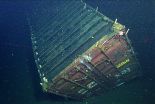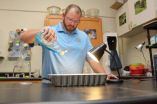(Press-News.org) MOSS LANDING, CA — Thousands of shipping containers are lost from cargo vessels each year. Many of these containers eventually sink to the deep seafloor. In 2004, scientists at the Monterey Bay Aquarium Research Institute (MBARI) discovered a lost shipping container almost 1,300 meters (4,200 feet) below the surface of the Monterey Bay National Marine Sanctuary. In the first-ever survey of its kind, researchers from MBARI and the sanctuary recently described how deep-sea animal communities on and around the container differed from those in surrounding areas.
In February 2004, the cargo vessel Med Taipei was traveling southward along the California coast when severe winds and seas dislodged 24 shipping containers, 15 of which were lost within the boundaries of the Monterey Bay National Marine Sanctuary. Four months later, during a routine research dive using the remotely operated vehicle (ROV) Ventana, MBARI scientists discovered one of these containers on the seafloor.
In March 2011, a research team led by Andrew DeVogelaere of the sanctuary and Jim Barry of MBARI completed another ROV dive at the container. During this dive, they collected extensive video footage, as well as samples of seafloor sediment at various distances from the container. They then compared the animals found on the container, on the nearby seafloor, and on the surrounding seafloor out to 500 meters (a third of a mile) away from the container. In early May, 2014 they published their findings in the journal Marine Pollution Bulletin.
Josi Taylor, the lead author of the recent article, said that she was surprised to see how little the container had corroded in the seven years since it sank to the seafloor. Apparently, the near-freezing water and low oxygen concentrations in the deep sea slowed the processes that might degrade sunken containers in shallower water.
As expected, the hard surface of the container acted somewhat like a rocky reef, attracting animals such as tubeworms, scallops, snails, and tunicates. Such animals require hard surfaces on which to attach, and were not found on the muddy seafloor around the container. Surprisingly, several types of animals found on nearby rocky reefs, such as sponges, soft corals, and crinoids (a distant relative of sea stars), had not colonized the surface of the container.
The researchers speculate that some of these slow-growing animals might not have had enough time to colonize the container's surface. Another possible explanation is that some types of animals may be sensitive to the potentially toxic effects of corrosion-resistant coatings used on shipping containers. The team conducted a follow-up ROV dive in December 2013 to study possible effects of the container's coating. The samples from this dive are still being analyzed.
The researchers also discovered differences in the types of animals living on the muddy seafloor within about 10 meters (32 feet) of the container. Within this zone, deep-sea snails in the genus Neptunea and some types of crabs and fish, including deep-sea rockfish, were more abundant than in surrounding areas, while sea pens and other filter feeders were less abundant.
Overall, the researchers suggest that the container caused shifts in animal communities through a variety of processes. Its physical presence provided: 1) a hard surface that sessile (attached) animals colonized; 2) a physical obstacle that affected local bottom currents, 3) a high spot on the seafloor that attracted predators, and 4) a possible source of toxic materials.
The researchers also believe the container is having indirect ecological impacts, some of which may take years or decades to develop. For example, higher numbers of seafloor predators near the container might explain some of the changes in the types of other animals found on the nearby seafloor. Such indirect ecological effects might also explain why the diversity of seafloor animals was lower near the container.
This collaborative research project has already helped government agencies in formulating standards for how containers are weighed, stacked, and lashed down. It has also spurred interest from both governmental agencies and the shipping industry in finding a way to track the number of containers lost at sea each year. DeVogelaere noted, "The fact that our research was mentioned by the U.S. Coast Guard in the background material for a proposed lashing rule shows that this work has clear societal value."
During future dives to the container, the researchers hope to find out whether more diverse animal communities will develop over time, or if some toxic material is allowing only certain hardy animals to colonize the container. They are also designing a study to compare the effects of different types of container coatings on colonization by deep-sea animals.
This particular container held a shipment of car tires. Other containers are used to transport more acutely toxic materials, such as batteries, pesticides, and raw chemicals. These substances would only add to the possible effects of a sunken container.
Given the slow rate at which the sunken container is corroding, and evidence from deep-sea shipwrecks such as the Titanic, the researchers hypothesize that lost containers may take hundreds of years to fully degrade in the deep sea. This suggests that each year thousands of shipping containers are accumulating on the deep seafloor, especially along busy shipping routes.
Taylor said, "We have only begun to characterize the potential long-term impacts of a single container on a deep-sea community. Although the effects of one container may seem small, the thousands of shipping containers lost on the seafloor each year could eventually become a significant source of pollution for deep-sea ecosystems."
INFORMATION:
Link to on-line version of news release:
http://www.mbari.org/news/news_releases/2014/container-animals/container-animals-release.html
Link to images associated with this news release:
http://www.mbari.org/news/news_releases/2014/container-animals/container-animals-images.html
MBARI YouTube Video about this release:
https://www.youtube.com/watch?feature=player_embedded&v=vFxtNsUPRKE
First-ever study describes deep-sea animal communities around a sunken shipping container
2014-05-08
ELSE PRESS RELEASES FROM THIS DATE:
Mouse study offers new clues to cognitive decline
2014-05-08
New research suggests that certain types of brain cells may be "picky eaters," seeming to prefer one specific energy source over others. The finding has implications for understanding the cognitive decline seen in aging and degenerative diseases such as Alzheimer's and multiple sclerosis.
Studying mice, investigators from Washington University School of Medicine in St. Louis showed that a specific energy source called NAD is important in cells responsible for maintaining the overall structure of the brain and for performing complex cognitive functions. NAD (nicotinamide ...
Improving air quality in NYC would boost children's future earnings
2014-05-08
Reducing air pollution in New York City would result in substantial economic gains for children as a result of increasing their IQs. The study is the first to estimate the costs of IQ loss associated with exposure to air pollution, and is based on prior research on prenatal exposure to air pollutants among low-income children by Frederica Perera, PhD, lead author of the current study, and colleagues at the Columbia Center for Children's Environmental Health at the Mailman School of Public Health.
The researchers made their calculation using a hypothesized modest reduction ...
Listening to bipolar disorder: Smartphone app detects mood swings via voice analysis
2014-05-08
ANN ARBOR, Mich. — A smartphone app that monitors subtle qualities of a person's voice during everyday phone conversations shows promise for detecting early signs of mood changes in people with bipolar disorder, a University of Michigan team reports.
While the app still needs much testing before widespread use, early results from a small group of patients show its potential to monitor moods while protecting privacy.
The researchers hope the app will eventually give people with bipolar disorder and their health care teams an early warning of the changing moods that ...
Why a bacterium got its curve -- and why biologists should know
2014-05-08
Drawing from his engineering background, Princeton University researcher Alexandre Persat had a notion as to why the bacteria Caulobacter crescentus are curved — a hunch that now could lead to a new way of studying the evolution of bacteria, according to research published in the journal Nature Communications.
Commonly used in labs to study cell division, C. crescentus naturally take on a banana-like curve, but they also can undergo a mutation in which they grow to be perfectly straight. The problem was that in a laboratory there was no apparent functional difference ...
Population screening for SCD in young people: Feasible with basic screening program
2014-05-08
Amsterdam, 8 May 2014. Despite fears over cost, the wide-scale screening of young people to detect risk of sudden cardiac death (SCD) is feasible and cost effective, according to a study presented at EuroPRevent 2014.(1) More than 12,000 people aged between 14 and 35 were screened at a cost of £35 (40 euro) each; rates of subsequent referral for further investigation were low and considered of "a relative low additional cost" to health services.
The study was reported at the EuroPRevent congress 2014 in Amsterdam by Dr Rajay Narain, Clinical Research Fellow from the Department ...
Adults with autism virtually learn how to get the job
2014-05-08
CHICAGO --- Adults with an autism spectrum disorder, who may have trouble talking about themselves and interacting socially, don't always make good impressions in job interviews and have low employment rates.
A new human simulation training program -- based on software originally used to train FBI agents -- helps adults with autism improve their job interview skills and confidence, reports a new Northwestern Medicine® study.
The new interactive program was designed specifically for adults with psychiatric disorders and was also evaluated for use by adults with autism ...
Hybrid SPECT-CT greatly improves localization of gastrointestinal bleeding
2014-05-08
Leesburg, VA, May 8, 2014—Prompt and accurate localization of the site of bleeding is critical for the management of patients with acute GI bleeding. Planar 99mTc-labeled RBC scintigraphy is sensitive for detection of acute gastrointestinal (GI) bleeding but its accuracy for localization of a bleeding source is arguable, particularly in patients with complex GI anatomy from prior surgeries.
Researchers at the Cleveland Clinic reviewed cases of GI bleeding in patients who had a concurrent hybrid SPECT–CT for evaluating equivocal 99mTc-labeled RBC activity on planar scintigraphy. ...
Gluten-free diet reduces risk of type 1 diabetes in mice
2014-05-08
New experiments on mice show, that mouse mothers can protect their pups from developing type 1 diabetes by eating a gluten-free diet. According to preliminary studies by reseachers at the University of Copenhagen, the findings may apply to humans.
More than 1% of the Danish population has type 1 diabetes, one of the highest incidence rates in the world. New experiments on mice now show a correlation between the health of the pups and their mothers eating a gluten-free diet. Our hope is that the disease may be prevented through simple dietary changes, the researchers say.
"Preliminary ...
Partisan media driving a wedge between citizens, study finds
2014-05-08
COLUMBUS, Ohio – Viewing partisan news reports from both the conservative and liberal viewpoints doesn't make people more accepting of citizens on the other side of the political fence, new research finds.
A study of people in the United States and Israel examined citizens' media consumption: specifically, how often they viewed liberal and conservative news outlets and how often they viewed mainstream, relatively neutral news sites.
Results showed that people who consumed a greater amount of partisan media content were more polarized – even if they viewed partisan content ...
Homemade stink bug traps squash store-bought models, Virginia Tech researchers find
2014-05-08
A Virginia Tech team of researchers has proven that homemade, inexpensive stink bug traps crafted from simple household items outshine pricier models designed to kill the invasive, annoying bugs.
This discovery comes just as warm weather is coaxing the critters out of crevices of homes they were hiding in during the cold winter and homeowners will be looking for a way to get rid of the pest.
Researchers in the College of Agriculture and Life Sciences found that the best way to get rid of the little buggers is to fill a foil roasting pan with water and dish soap and ...




